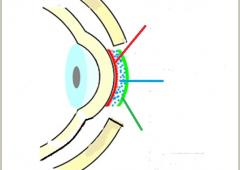This is caused by instability of the preocular tear film, which lies on the surface of the eyeball between the eyelids. It consists of 3 layers: an outer lipid layer, a middle aqueous layer and an inner mucin layer (Fig. 1). Consequently, the tear film can be affected by disorders relating to the production of lipids, mucin or tears in the secretion glands of the conjunctiva and lacrimal glands. Other causes of Dry Eye Syndrome are defects in the eyeball’s surface or edges of the eyelids, reduced blinking, internal ailments or environmental and work-related factors (e.g. air conditioning and working with computers). The most common symptoms are irritation, a sensation of foreign matter being present, burning, photophobia and complaints of dry eyes. An ocular examination and special tests (Schirmer’s test, break-up time test, rose bengal staining, LIPKOF and others) are necessary to diagnose Dry Eye Syndrome. In some cases an internal medical examination is required. If the Dry Eye is caused by the diminished production of tears, the remedy consists of applying “artificial tears”, sometimes in combination with anti-inflammatory agents. Otherwise, the treatment depends on the given case and its particular cause.
